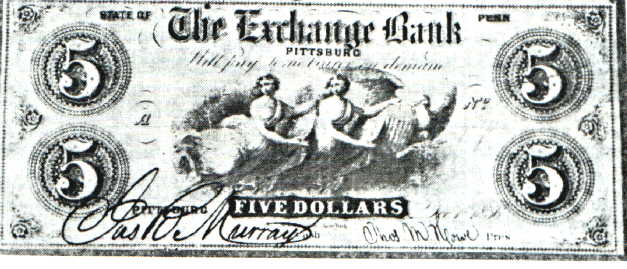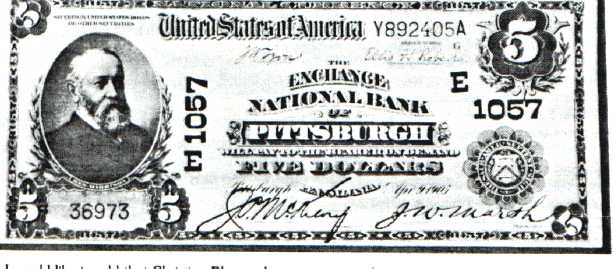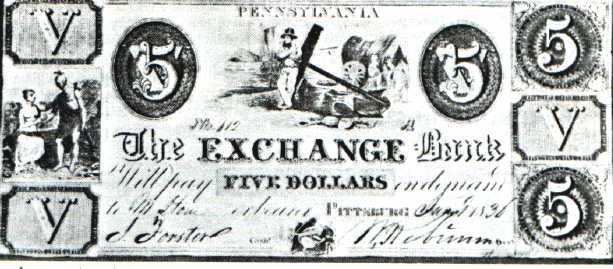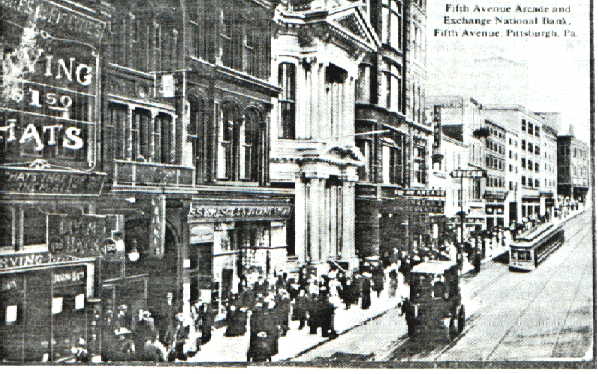My Adventures in Collecting Bank Notes from The Exchange Bank of Pittsburgh
I started to collect coins in 1945 while I was a Boy Scout. It was basically filling holes with different dates and mint marked Lincoln cents, Jefferson nickels, etc., in the popular blue Whitman folders. After I was out of school, and with more money to finance my hobby, my interests turned to collecting currency. I had also become bored with series collecting. Filling another hole in the book was an accomplishment, but it had lost its enjoyment at the time. The counterfeiting of the scarcer dates also became a negative factor. Currency had become my new collecting interest.
I had become very fascinated with national bank notes and the early state chartered obsolete notes. In 1956 some national bank notes (small size -- series 1929) could still be found in circulation. At coin shows, many notes could be bought for $1 to $5 over face value. Very few collectors wanted them because the high face value of collecting $5 through $20 notes represented "dead money", since they would probably never be redeemed at face value. The one cent to one dollar denominational series collecting was then popular due to the low face value cost involved.
Collecting the old obsolete and national bank notes was fascinating because each note is unique in name. Each note has a different serial number and the early obsolete and large-size notes were hand signed by the president and cashier of the bank that issued the notes. This gave each piece of currency a personality. Many of the signers were historical figures of the community. The number of banks increased as the population of a community increased. The serial number also provided a security mark that coins did not have.
In 1961 the Society of Paper Money Collectors was organized and I became charter member No. 33. This was a great aid to currency collecting in general, but has been especially helpful in collecting small-size national bank notes. Until then, there were no reference books to detail the existence of banknotes on particular banks. Even now (1985), after almost 25 years, PAPER MONEY is still reporting new data.
Due to the security problem that all collectors face, we never fully enjoy our most treasured finds, since they all invariably end up in a safe deposit box in our bank as part of an accumulation. In order to enjoy my collection more, I recently bought a 35 mm camera with a macro-focusing zoom lens, and have started the enjoyable task of photographing my collection. By using either slides or prints, I now can fully enjoy my collection while it still remains in a safe place.
While I was photographing my notes, my mind took me back to the collectors, dealers, places and good times when I found these notes. Each note began to represent friends of the past, good times at the many shows I attended in search of my "treasures." I mentioned earlier that when I first started collecting currency the face value represented a major portion of the value of the note. With the increasing popularity in bank note collecting in 1985, only twenty-nine years later, scarce notes command higher prices. Now the face value often represents a small percentage of the note's value.
Now that I have expressed some of the reasons why I turned to collecting currency, and the changes in this specialized field of the hobby, I would like to share my thoughts with you, which I have titled, "My Adventures in Collecting Bank Notes from The Exchange Bank of Pittsburgh, Pennsylvania. I have been doing detailed research on about thirty different banks. This is one of my favorite banking journeys that I trust you will enjoy taking with me.
In 1963 I attended a Pittsburgh Numismatic Society Coin Show at the old William Penn Hotel in Pittsburgh. It was held in the balcony area of the hotel. The quarters were tight, very hot, poorly lit, and designed in a "horse-shoe" shaped hallway on the second floor. It was a relatively small show, similar to those held during the great 1960’s numismatic boom. I did not know then, but that show would play an important part in laying the cornerstone of a collection of currency on The Exchange Bank of Pittsburgh in the years to follow.
 National $5 Note
National $5 NoteWhile at the bourse table of Mrs. Vi Mason, a well-known and respected Pittsburgh dealer, my eye caught the beauty of a First Charter 1875 Series $5 note on the Exchange Bank of Pittsburgh, PA. It was in XF-AU condition and priced at $29, which, at the time, I considered o be a lot of money. However, it was too nice to pass up. The art work on the First Charter notes is beautiful. To consider that in the future these same notes would be a good investment, didn't enter my mind. Today, it seems that many things are being sold where only investment is stressed instead of buying just for pleasure. Purchases from the times I have bought for fun and enjoyment have turned out to be better investments than those purchased for the sole purpose of investing.
 State $5 Note
State $5 NoteI was proud of this beautiful $5 bank note, and so I showed it to my friend, Radian Litvinovich. While attending the 1964 Florida Fun Show, he remembered the bank's name, so he picked up an old $5 State Bank Note on the Exchange Bank dated Dec. 1, 1856, for me. Now I had a state and national bank note from this bank.
 $5 1882 Brown Back
$5 1882 Brown BackI put these two notes in a plastic holder to exhibit, as well as show them to another collector friend of mine, Alex Maletich, who asked, "How would you like to have a $5 1882 brown back from this same bank?" That was three years later, in April of 1966. Now I had three notes! It does pay to show your collectibles to your fellow numismatists! In that same year, I also picked up a $2 note dated May 4, 1841, from Richard Hoober.
Six years went by before I saw another Exchange Bank note. In a Kagin's auction catalog in October 1972, a lot was listed as having a 1902 plain back $5 note and a 1929 Type I $5 note on this same bank with Charter 1057. These two became numbers 5 and 6 in my collection.
I knew that the bank opened its doors in June 1836. This information was obtained from the Carnegie Library in Pittsburgh. The library has a file of newspaper clippings that were very helpful in my research and quest for more knowledge on this bank.
My big dream came true when, six months later, in April 1973, a $5 note --dated June 1, 1836--was listed in a Jess Peters' auction catalog. That note represents the first $5 type note on the bank. With the good Lord's blessing, I received the winning bid. It was in XF-AU condition and was serial No. 112. It was probably from the first lot of notes signed for opening day. Now I had six of the same denomination.
 1902 $5 Note
1902 $5 NoteMy goal now was to obtain a complete type set of $5 notes from 1836 to 1929. In December 1975, 1 discovered a 1902 $5 dated-back note in very fine condition in one of Jess Peters and Don Fischer's fixed price lists. Now I had seven different $5 notes representing years 1836, 1856, 1875, 1882, 1902 and 1929, a good spread representing the banking years as a state and national bank. In 1980 I also obtained a $10 note of series 1882 brown-back from a Hickman-Oakes auction catalog. This was my second note that was not a $5 note.
I would like to add that Christian Blom, who is an active collector-dealer in obsolete currency, sent me a photocopy of a proof sheet of the Exchange Bank notes of denominations $500, $500, $1000, $1000, circa 1859. He mentioned that they were not for sale, but he thought I would appreciate it since he was aware that I collected early Pittsburgh notes. Having a copy of this rare sheet made me all the more appreciative of his thoughtfulness. The notes depict vignettes of Greek figures. They were very popular on the currencies in the late 1850s. No notes of these high denominations exist today. If issued, they were probably used for transactions between banks rather than for general circulation.
Still in search of Exchange Bank notes, in May of 1983 I secured from a fixed price list by Dr. Douglas Ball of NASCA, a $1 note dated May 1, 1861. Even though it was in less than good condition (with a piece missing from the right side), I was happy to be able to acquire a specimen of this rare issue, and add it to my collection. I gained a feeling of pride to further preserve the history of this bank. A $2 note dated May 4, 1841 was also purchased from the same list.
The year 1984 brought me another surprise when Mr. Roy Van Ormer, a member of W.P.N.S., showed me a $20 proof note circa 1859. I did not buy the note, but he wanted me to have a copy for my project after I presented this program at one of the W.P.N.S. monthly meetings.
Well, in 1985, twenty-nine years after I bought my first Ex change Bank of Pittsburgh note, I am still engaged in seeking notes and data in order to preserve the history of this early Pittsburgh bank.
In a mail bid auction list from Ed’s Currency January 1985, I discovered he had a $100 Red Seal note of series 1902. Knowing that I could not afford to bid on such a rare and high priced note, he was happy to send me a photocopy on request. By the way, the note did bring $2,300.
In a fixed price list from a dealer in Boston I also saw a $5 type note, dated 1861, that I needed. Confident that I would get the note with my fast order, I received a "sorry sold out" notice.
I find that just adding data or photocopies of notes to my research project is as much fun as adding the real note to my collection.
Many thanks for letting me share "My Adventures in Collecting Bank Notes from The Exchange Bank of Pittsburgh, PA."
As a help in future bank note research, I am very pleased that the SPMC Book Project has just released their latest, long-awaited book "Pennsylvania Obsolete Notes and Scrip" by Richard T. Hoober. I have also just ordered the latest D. C. Wismer reprint "Obsolete Banknotes of Pennsylvania" published by S. J. Durst. These two books will be important to me because I am gathering data on forty pre-Civil War Pittsburgh banking institutions. My goal is to have my research published on "Early Pittsburgh, Pennsylvania Banking from 1810 to 1866".
HISTORY OF THE EXCHANGE BANK OF PITTSBURGH, PA.
Received State Charter . . . . . . . . . . . . . . . . . . . May 18, 1836
Opened for Business . . . . . . . . . . . . . . . . . . . . . June 1, 1836
National Bank Charter . . . . . . . . . . . . . . . . . . . . Aug. 8, 1865
Closed Business . . . . . . . . . . . . . . . . . . . . . . . . Oct. 19, 1931
Into Receivership . . . . . . . . . . . . . . . . . . . . . . . Oct., 23, 1931
The Exchange Bank of Pittsburgh, PA was officially founded on May 18, 1836, with a state charter. It opened for business the next month on June 1, 1836, in a small building on the north side of Second Avenue between Market and Perry Streets. Its founding President was William Robinson, Jr., who was to become the first mayor of Allegheny City just four years later, on April 17, 1840.
The banking institution soon moved to a larger building at 240 Fifth Avenue; the exact date is not known. Twenty-nine years later, on April 8, 1865, the bank gave up its state charter and joined the National Banking System and received Charter 1057. With capital assets of $1,000,000, it was hailed as the biggest bank in Pittsburgh. It surpassed the growth of The Bank Of Pitts burgh -- the oldest bank -- which had started in 1810.
 Exchange Bank Building
Exchange Bank BuildingThirty-eight years later, in 1874, a new bank building was erected on the same grounds. I have no source of information to indicate where the temporary quarters of the bank was located while the new building was under construction. The Pittsburgh Post Gazette remarked that the new 1874 bank was erected at street level. It goes on to state that the old landmark, which was raised, had stood above street level and that there were many long steps up to the entrance. This caught my attention and I wondered if Fifth Avenue had been lowered after this building had been erected. This may have left the building above street level and the steps were added afterward. Also in my search for more information, I located some flood data for the period 1816-1836. Floods occurred almost every year with depths of thirty-two to thirty-eight feet. With today's top flood stage at twenty-five feet above normal river level, due to our system of dams, could it be possible that the old bank building was purposely built above street level for flood protection? It’s an interesting observation.
To get back to the history of the bank, I found that this third bank building served the bank until 1922, or forty-eight years more. The bank proper was moved to temporary quarters on Fourth Avenue during the construction of the biggest, most modern banking facility of its time. Around November 17, 1923, the bank opened in new quarters and has remained at the same location since shortly after 1836. The Exchange National Bank, after eighty-seven years of operation, was hailed as the largest and most modern banking institution in Pittsburgh. A large public reception was held for this great banking milestone. This new building was a seven-story granite and steel structure erected according to the principles of modern banking architecture. It provided full banking services with safe-deposit boxes, management service and with attorneys on the top floor. It was banking at its finest. Three years later, in 1926, the bank celebrated its 90th anniversary with another big celebration.
No one knew then that this was the peak of the bank's success and that it would not last to celebrate its centennial year as The Bank of Pittsburgh had done in 1910. The great depression hit and the small banks started to fail after the stock market crash on October 29, 1929. Compared to the nation as a whole, Pittsburgh banks held up well during the early years of the depression between 1929 and 1931. But on September 21, 1931, when word got out that the Bank of Pittsburgh had gone into receivership and closed, a run started on all the banks. Pittsburgh's oldest bank had operated for 121 years. Its closing was a devastating blow to the financial world.
The Exchange Bank of Pittsburgh also suffered bank panic. On October 19, 1931, the Exchange Bank gave notice in the Post Gazette that " . . . this morning, the directors voted not to open the bank." It stated that the bank was experiencing such high levels of withdrawals that it could no longer operate under such adverse conditions. The Board of Directors called the Comptroller of the Currency to take charge of the bank in the interest of the stockholders and the depositors. Continuing abnormal cash withdrawals would only have required undue sacrifices of securities and other assets to provide cash.
This event closed the Exchange Bank of Pittsburgh after ninety-five years of service (1836-1931). Neither of these two banks ever opened again, nor did they merge with another bank to survive. In the ninety-five years of service, the bank had only six presidents whose signatures are found on the notes I exhibit. These are a collection in themselves.
REFERENCES
Beldon L. Daniels, Birthplace of Banking in America, Pennsylvania Bankers Association
John Hickman, Dean Oakes, Standard Catalog of National Bank Notes, Krause Publications.
Richard T. Hoober, Pennsylvania Obsolete Notes and Scrip, The Society of Paper Money Collectors.
Peter Huntoon, Louis van Belkum, M. Owen Warns (ed.), The National Bank Note Issues of 1929-1935, The Society of Paper Money Collectors.
Stefan Lorant, The Story of an American City.
Pittsburgh and Bankers Publication Company (1908-1909). The Pittsburgh Post Gazette (clippings at Carnegie Library).
For their assistance I would like to thank the following: Mrs. Vi Mason, Radian Litvinovich, Alex Maletich, Jess Peters, Don Fisher, Kagin's, Christian Blom, John Hickman, Dean Oakes, Richard Hoober, NASCA, Roy Van Ormer and Ed's Currency.